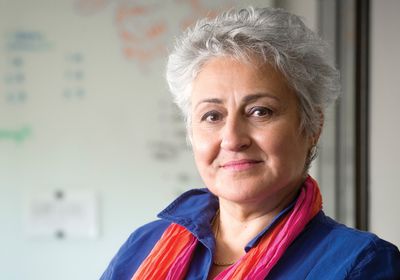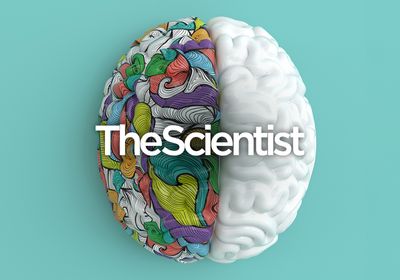ABOVE: Haydeh Payami studies the interaction of the human genome, gut microbiome, and environmental factors in causation, progression, and treatment of Parkinson’s disease. University of Alabama, Birmingham
At the age of 19, Haydeh Payami, now a geneticist at the University of Alabama, Birmingham, left Iran and came to the United States with two suitcases and a fascination with genetics. In the following years, she pursued a doctoral degree in genetics and trailblazed her path as a researcher. Today, Payami leads a team of motivated researchers and combines her love of genetics with the microbial world to find ways to prevent and treat Parkinson’s disease.
“Haydeh has certainly been a pioneer,” said Sarkis Mazmanian, a gut microbiome researcher at the California Institute of Technology, who believes that Payami’s work contributed greatly to instilling confidence in the idea that changes in the gut microbiome are not a secondary consequence of Parkinson’s disease, but may actually contribute to it.
Payami’s interest in Parkinson’s disease did not begin with the microscopic inhabitants of the human gut. It started with a genetic investigation.
A genetic component of Parkinson’s disease?
In the early 1990s, Payami led a group at the Oregon Health and Sciences University that studied the genetic basis of Alzheimer’s disease. One day, an undergraduate student approached her with the idea of investigating the genetics of Parkinson’s disease. “I said, ‘Well, that’s fine. But choose either Parkinson’s or genetics because Parkinson’s doesn’t have a genetic component,’” Payami recalled. “This was 1992. Everybody was convinced that Parkinson’s was purely environmental.”
At that time, the only well accepted case of a genetic link to Parkinson’s disease was an Italian family where individuals from different generations suffered from the disease.1 Motivated by the student’s determination to pursue the idea and the lack of knowledge about the role of genetics in Parkinson’s disease beyond that case, Payami and her colleagues conducted a family study to detect the presence of familial aggregation for the disease.
The team looked at the family histories, including individual records of illnesses and health conditions along with records of parents and siblings of patients with Parkinson’s disease. Spouses or friends served as controls to help identify characteristic symptoms, including tremors, rigidity, and disease diagnoses. First-degree relatives of patients showed an increased risk for developing Parkinson’s disease, as indicated by a higher number of patients with a parent or sibling with symptoms or a diagnosis of the brain disorder.2 “We published that paper in 1994 and braced for the world to come down on us,” Payami said.
The reactions were mixed, she recalled. While some scientists resisted the idea that genes play a role in cases of Parkinson’s disease with unknown causes, others were more open and embraced the new discovery.
Since the mid-1990s, Payami and others have linked 90 risk loci to Parkinson’s disease,3 but these genes still did not explain the whole story. So, Payami turned her attention to investigating how environmental factors and their interactions with genes influence the disease. In one study, for instance, her team conducted a genome wide association study (GWAS) to investigate how genes influence the protective effects of coffee in Parkinson’s disease. They found that heavy coffee drinkers who carried a variant of the gene GRIN2A, which encodes a glutamate receptor involved in excitatory transmission in the brain, had a lower risk for developing Parkinson’s disease.4
Although her findings added to other evidence that the environment influences this neurodegenerative disorder, a gene-environment interaction still did not provide all of the pieces of the puzzle. “What else is there if it’s not genes and environment?” Payami puzzled. Then, the boom in microbiome research in the 2010s gave her a new clue.
Gut microbes in action
The study of the microbiota traces back to the 17th century, when Antonie van Leeuwenhoek used his handmade microscopes to describe the animalcules he found in people’s mouths and stools. However, in the last 20 years, the human-associated microbiota research area has experienced a surge, as scientists have developed novel -omics approaches and bioinformatics tools to understand the impact and influence of these microscopic beings on the human body, including on the brain.
In the mid-2010s, Mazmanian’s team uncovered a connection between the gut microbiome and hallmarks of Parkinson’s disease in a mouse model of the disease.5 In human studies, however, the association was less clear, and inconsistencies between studies made the link difficult to establish.
Haydeh has certainly been a pioneer.
—Sarkis Mazmanian, California Institute of Technology.
“It was kind of a Wild West of a research area,” said Zachary Wallen, a medical bioinformatician at Labcorp Oncology and a former student of Payami’s. “There was no standardization of anything; there were no guidelines to go by. So, we just had to pave our own way to figure out how to tag the microbiome to Parkinson’s disease in the most robust way possible.”
Payami’s team set out to determine if an imbalance, or dysbiosis, of the gut microbiome was present in patients with Parkinson’s disease. They collected stool samples from patients and neurologically healthy individuals, extracted DNA, and sequenced the 16S rRNA to determine the microbial composition. The team’s initial results provided evidence of an imbalance in the gut microbes of patients, uncovering an abundance of some bacterial taxa and a reduction in others.6
Next, the team characterized gut dysbiosis in Parkinson’s disease in more detail by using more advanced bioinformatics tools in their microbiome-wide association studies, which they modeled after the rigor and standards of GWAS. They identified an overabundance of opportunistic pathogens, bacteria that are normally harmless but can cause infections in immunocompromised individuals, in the microbiomes of patients with Parkinson’s disease.7 Although this was the first time that a group of potentially pathogenic microbes was found in samples from patients with this neurodegenerative disorder, the idea that a pathogen could trigger the disease was not entirely new.
In 2003, the anatomist Heiko Braak and his colleagues proposed that nonfamilial forms of the disease could be initiated in the gut by an unknown pathogen.8 After entering the body through the nasal cavity and reaching the gut, this pathogen triggered the formation of abnormal aggregations of the alpha-synuclein protein, a hallmark of Parkinson’s disease. These aggregates then spread from the periphery to the brain via the vagal nerve and olfactory tract, causing progressive brain cell dysfunction and loss.
The identification of these opportunistic pathogens is one of Payami’s major contributions to the field according to Wallen. It is still uncertain whether any of them is the disease triggering pathogen that Braak referred to, but revealing their identities will allow researchers to test their specific involvement in Parkinson’s disease.
More recently, Payami’s group used a metagenomic approach instead of 16S rRNA sequencing to take a deeper look at the Parkinson’s disease gut microbiome. In this large-scale study, which included 490 patients with Parkinson’s disease and 234 neurologically healthy controls, they confirmed previous findings of an overabundance of opportunistic pathogens and uncovered microbial genes and pathways that may contribute to Parkinson’s disease pathology, such as dysregulation of the production and metabolism of neuroactive molecules and lower levels of anti-inflammatory molecules.9
Wallen, who spent his graduate and postdoctoral years under Payami’s supervision, remembers Payami’s determination to produce the best science and her collaborative nature the most. “She had an office; she hardly ever used it. We would just sit in the middle of our lab and talk because she just wanted to constantly talk and communicate,” he recalled.
According to Mazmanian, human studies like those conducted by Payami’s team could provide clues to potential interventions. For example, the opportunistic pathogens identified by her team could be targeted and potentially removed from an individual suffering from Parkinson’s disease. Additionally, supplementing patients with the beneficial anti-inflammatory bacteria they lack might also prove to be a viable strategy, he said.
Even though Payami’s main research goal is still to find a cure for Parkinson’s disease, she hopes that by looking at the microbiome, scientists can develop strategies to treat it.
“There are so many people who are suffering with this disease. They’re not at an early stage, and they’re being ignored as far as clinical trials,” said Payami. “Their microbiomes are sick. We may not change their Parkinson’s, but we might be able to give them some relief or maybe even slow disease progression.”
References
- Golbe LI, et al. A large kindred with autosomal dominant Parkinson’s disease.Ann Neurol. 1990;27(3):276-282.
- Payami H, et al. Increased risk of Parkinson’s disease in parents and siblings of patients. Ann Neurol. 1994;36(4):659-661.
- Bandres-Ciga S, et al. Genetics of Parkinson’s disease: An introspection of its journey towards precision medicine.Neurobiol Dis. 2020;137:104782.
- Hamza TH, et al. Genome-wide gene-environment study identifies glutamate receptor gene GRIN2A as a Parkinson’s disease modifier gene via interaction with coffee.PLoS Genet. 2011;7(8):e1002237.
- Sampson TR, et al. Gut Microbiota Regulate Motor Deficits and Neuroinflammation in a Model of Parkinson’s Disease.Cell. 2016;167(6):1469-1480.e12.
- Hill-Burns EM, et al. Parkinson’s disease and Parkinson’s disease medications have distinct signatures of the gut microbiome.Mov Disord. 2017;32(5):739-749.
- Wallen ZD, et al. Characterizing dysbiosis of gut microbiome in PD: evidence for overabundance of opportunistic pathogens.NPJ Parkinsons Dis. 2020;6:11.
- Braak H, et al. Idiopathic Parkinson’s disease: possible routes by which vulnerable neuronal types may be subject to neuroinvasion by an unknown pathogen.J Neural Transm (Vienna). 2003;110(5):517-536.
- Wallen ZD, et al. Metagenomics of Parkinson’s disease implicates the gut microbiome in multiple disease mechanisms.Nat Commun. 2022;13(1):6958.






